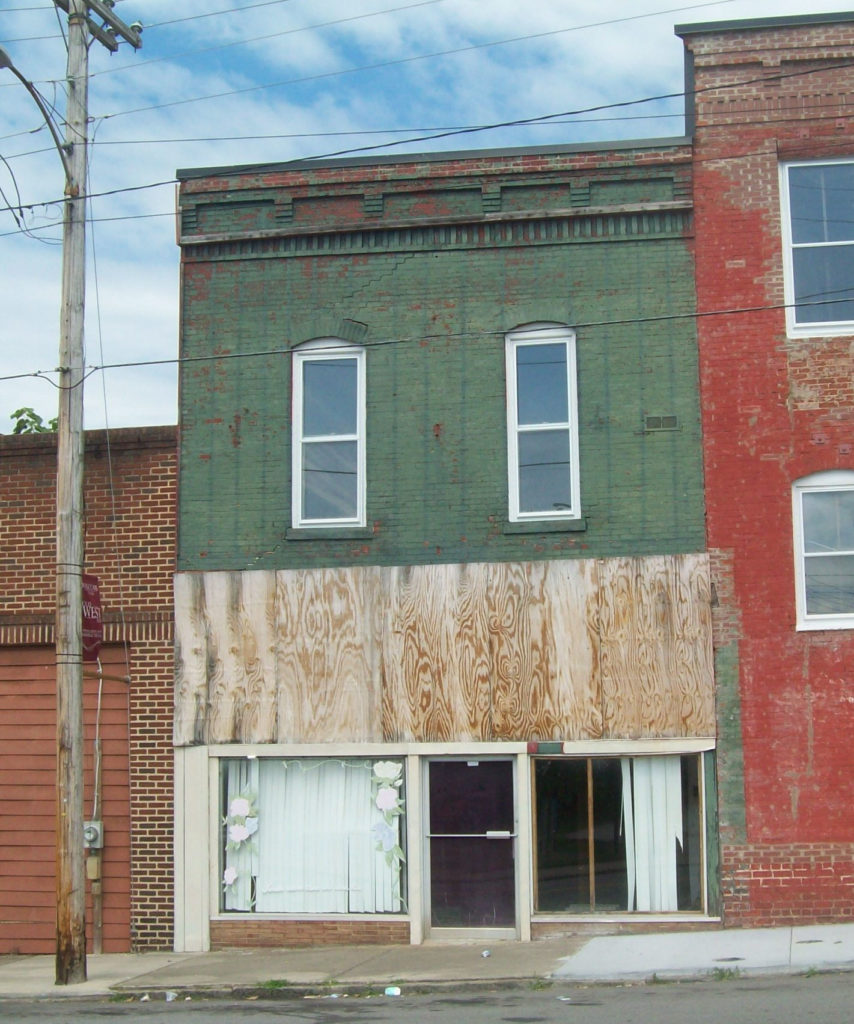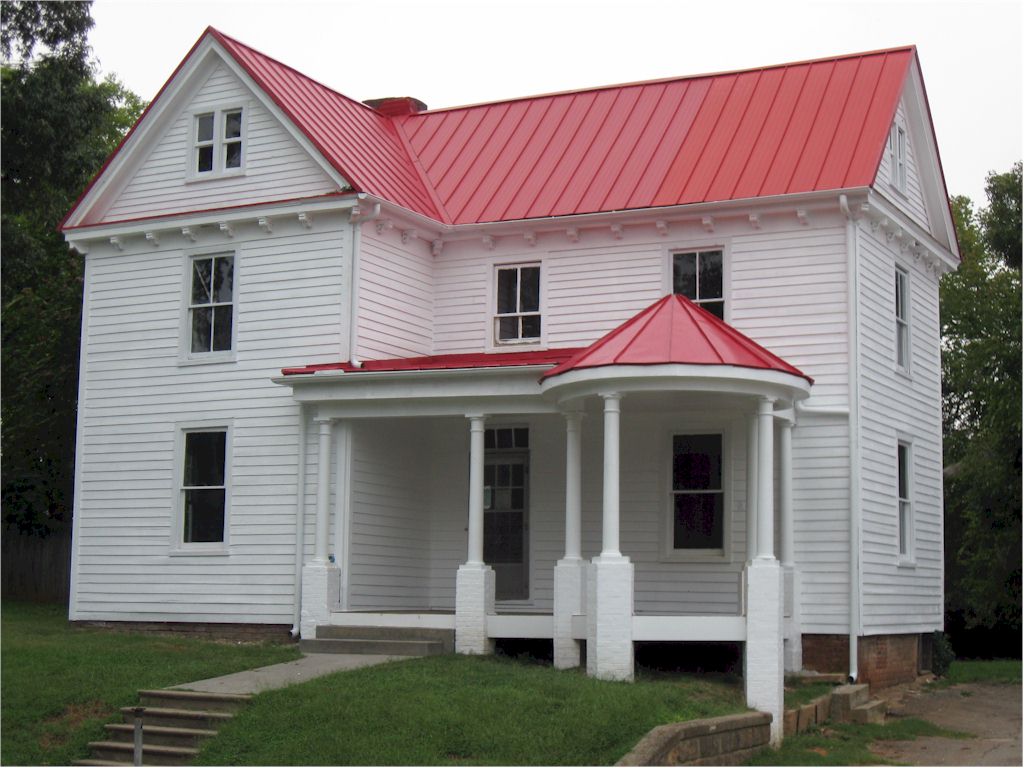 (Trigger warning: This article describes a case of suicide.)
(Trigger warning: This article describes a case of suicide.)
It’s not entirely certain when a home first appeared on the property located at 808 Green Street. In 1875, when William S. Patton, John R. Patton, William F. Patton, and A.Y. Stokes (operating under William S. Patton & Sons, Co.) transferred the property to Charlotte E. Lomax, the deed stated that the transfer of property included “appurtenances thereunto”. Indeed, the Beers map of 1877 identifies a home on the property.
 Charlotte Elizabeth Lomax was one of ten children born to John Tayloe (pictured left) and Charlotte Belson Thornton Lomax of Port Tobago, Essex County, Virginia. Charlotte was born in 1806 and was living with her parents in York County, Virginia at the time of the 1870 census. According to her will, she was extraordinarily fond of a niece, Catherine Rebecca Lewis Anderson, the daughter of her deceased sister. Catherine married John H. Anderson in Staunton, Virginia in 1866. It’s possible the couple made it as far west as Danville, but it’s unclear that Charlotte had any relatives here at all. Charlotte purchased her Green Street property in 1875 for $750, very likely with a building already on it (though perhaps a much smaller one than that which presently stands), and died of consumption (tuberculosis) just three years later, leaving the house to her niece, Catherine Anderson. As Catherine and her husband were in the D.C. area by that time, it seems the property was likely used as investment property. The 1890 directory indicates that a C.H. Myers, purveyor of wine and liquor, either lived there or operated an establishment on the property.
Charlotte Elizabeth Lomax was one of ten children born to John Tayloe (pictured left) and Charlotte Belson Thornton Lomax of Port Tobago, Essex County, Virginia. Charlotte was born in 1806 and was living with her parents in York County, Virginia at the time of the 1870 census. According to her will, she was extraordinarily fond of a niece, Catherine Rebecca Lewis Anderson, the daughter of her deceased sister. Catherine married John H. Anderson in Staunton, Virginia in 1866. It’s possible the couple made it as far west as Danville, but it’s unclear that Charlotte had any relatives here at all. Charlotte purchased her Green Street property in 1875 for $750, very likely with a building already on it (though perhaps a much smaller one than that which presently stands), and died of consumption (tuberculosis) just three years later, leaving the house to her niece, Catherine Anderson. As Catherine and her husband were in the D.C. area by that time, it seems the property was likely used as investment property. The 1890 directory indicates that a C.H. Myers, purveyor of wine and liquor, either lived there or operated an establishment on the property.
In 1888, Mrs. Anderson fell on hard times. She entered a chancery suit in order to establish her undisputed claim on the property so that she could sell it, and in 1889, the property went up for auction. The high bidders were F.X. Burton and W.J. Dance, operating under W.J. Dance, Co., who, by March of 1890, turned around and sold it to J.H. and A.W. Griggs with “buildings and improvements thereon and the appurtenances thereunto”, which at least reads as something of an improvement from when the property first fell into Miss Lomax’s hands.

James Henry and Archie Wesley Griggs were brothers, born just over a year apart, sons of George King Griggs, whom we’ve discussed in previous posts. Archie and James together were principal figures in the organization of the Danville & Western Railway. James was superintendent of the railroad company for many years, and, as a conductor of the railroad, Archie was said to have run the first train over the line. In later years he served as a station attendant before retiring to his farm in Patrick County and where he worked as a peace officer.
In 1898, Archie sold his interest in the house to his brother for a sum of $700. James continued to live in the house, along with several borders, until 1912 when he sold the property to G.A. and C.R. Myers. Whether these two gentlemen were of any relation to the C.H. Myers, whom the 1890 city directory had identified as a wine purveyor, is unclear. Four years later, in 1916, George Myers sold the property to S.J. Brown, and two years after that, in 1918, it became the home of Charles Robert Booth.

The house at 808 Green Street was the new home of Charles, 36, and his wife of two years, Louise. Louise brought with her, to the home and to the marriage, her three children by her first marriage, daughter Jane and twins Bennie and Coleman. The couple had two children of their own, Carmine and Charles, Jr.. Mr. Booth was a grocer, operating a store with his brother W. Irvin Booth just around the corner at 400 Jefferson Street.
In 1929, Bennie was 20 years old and already divorced when he purchased a packet of cyanide at a local druggist. After having written a bad check, he was in trouble with the law. When the police showed up at his home at 606 Patton Street, he took two cyanide tablets and soon after died. It was not his first attempt. While hanging out with friends at the Y.M.C.A. on Main Street, he swallowed mercury tablets, and only survived when a couple of friends intervened and carried him by force to the hospital. Not quite two years after Benny’s death, twin brother Coleman hanged himself in his bedroom in the home on Green Street.
Mr. and Mrs. Booth remained in the home until Charles’ death of a coronary thrombosis in May of 1959. Mrs. Booth remained until 1965 when she passed from a heart attack. Following the death of their mother, her surviving children sold the home to Robert Irvin Winn and the home became rental property until 2001 when it was acquired by Domestic Violence Emergency Services (DOVES), which operated a domestic violence shelter in the home. Abandoned and with years of unpaid taxes hanging over the property, the city took ownership in 2016 and stabilized the home in preparation for rehabilitation.

In 2018, the house underwent stabilization by the city and the Danville Redevelopment & Housing Authority. You can read more about that process here, and in August of 2021, the home was rescued when it at last found its most recent owner, Bryan Hale, who has painstakingly returned this house into a beautiful home, ensuring that the historic home will stand for many years to come. The property at 808 Green Street was consolidated with its neighbor at 812 Green Street, which home was demolished sometime during the “demolition craze” of the late 60s and 70s. You can learn more about that house here.
Sources:
Census and Vital records found at Familysearch.org
Death notices and other information found in the Danville Register, Danville Bee archives at Newspapers.com
Census, Directory, Newspaper, and other information compiled by Paul Liepe

Wow! I’m so glad this house is currently in good hands!